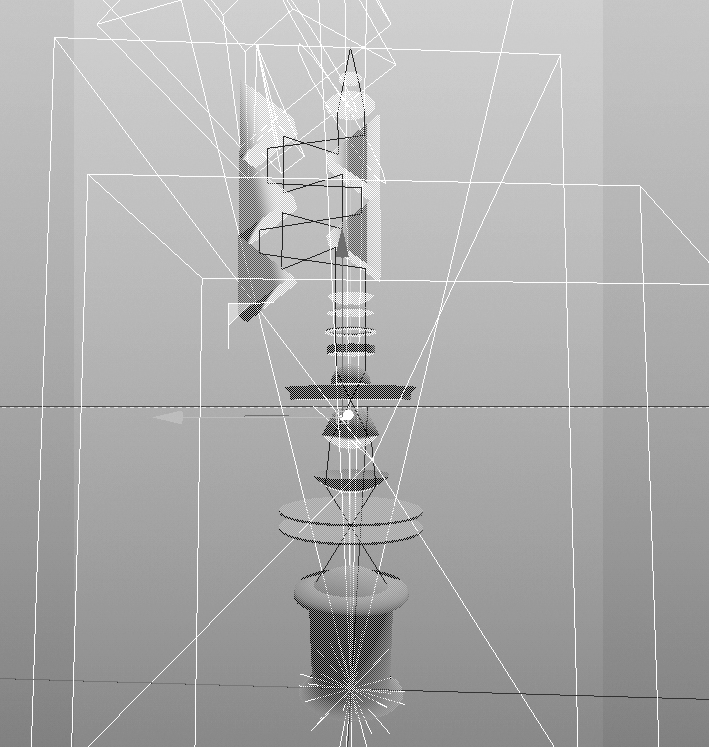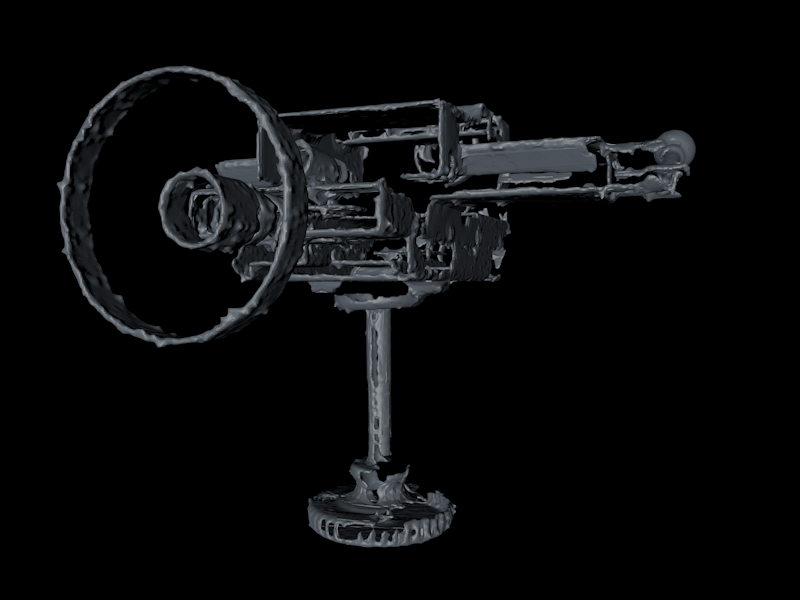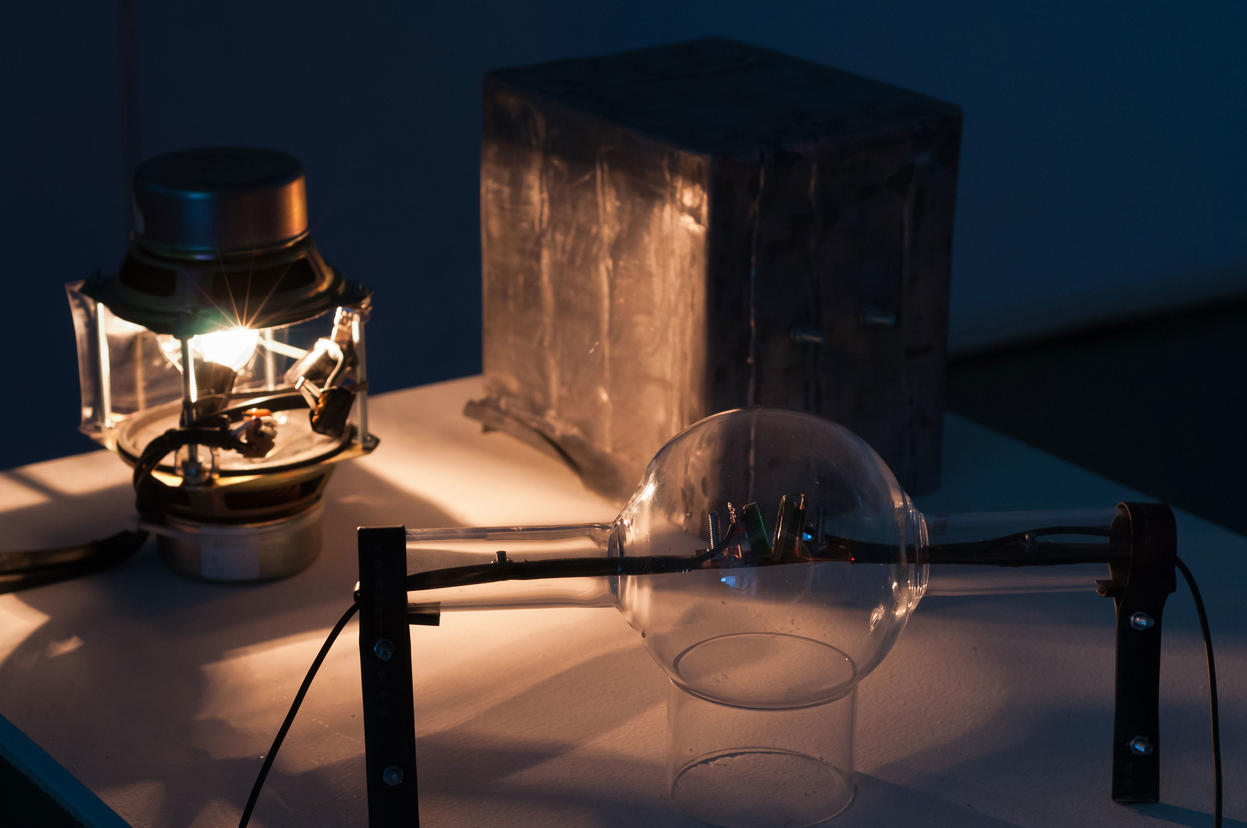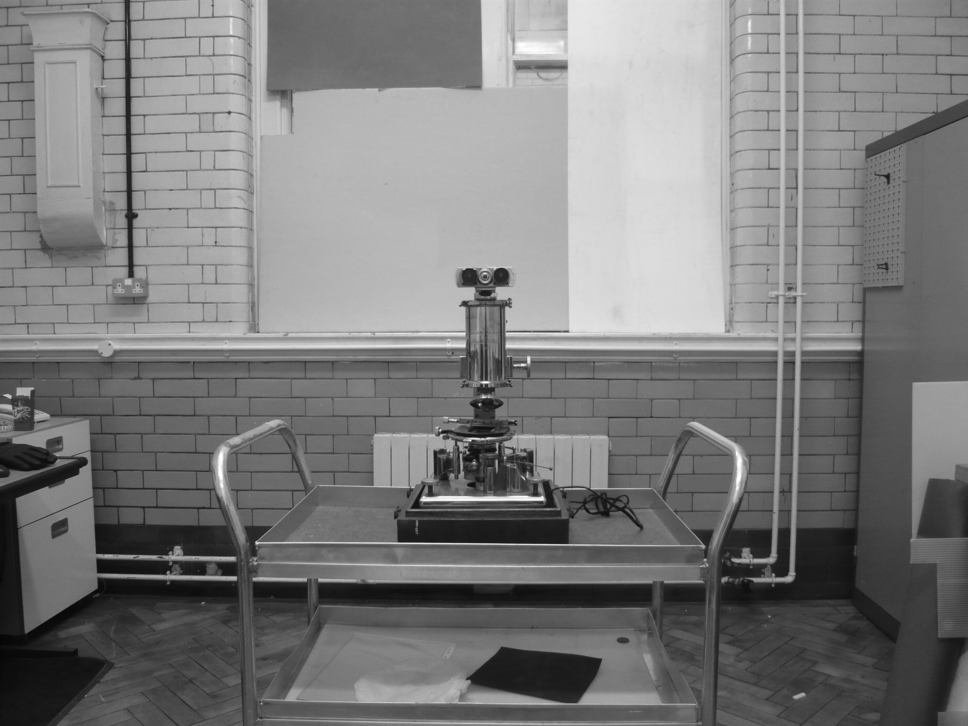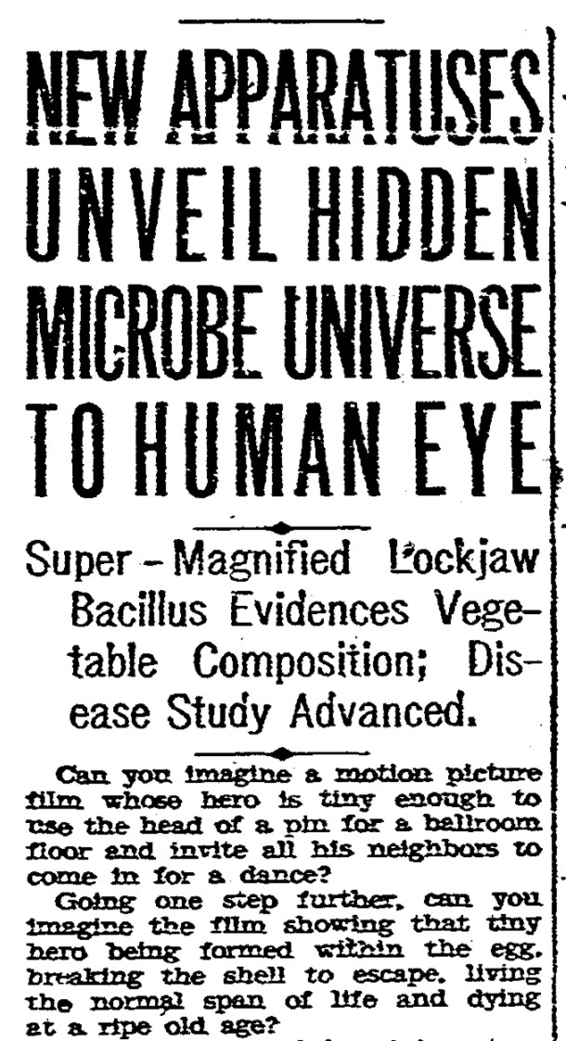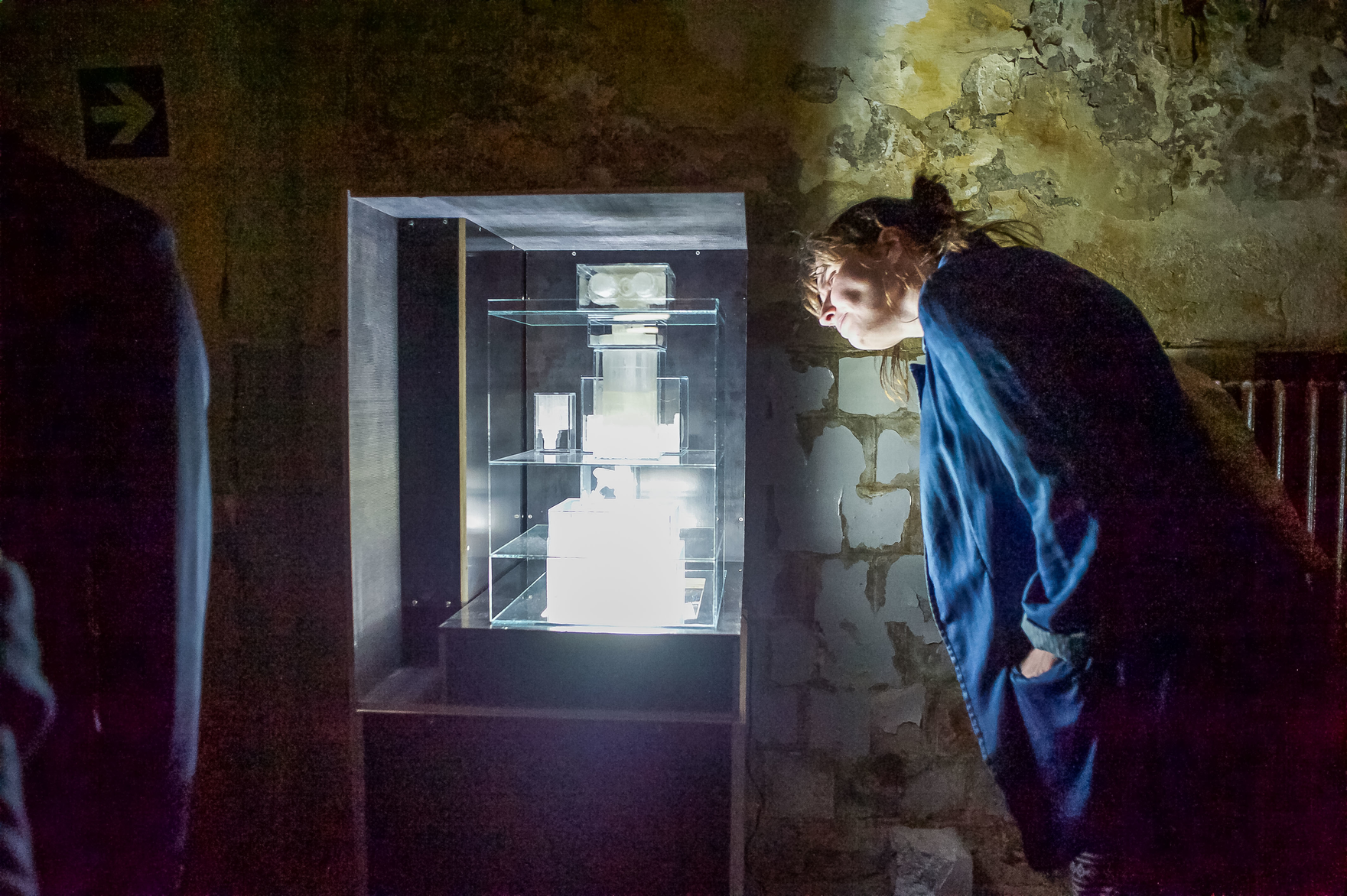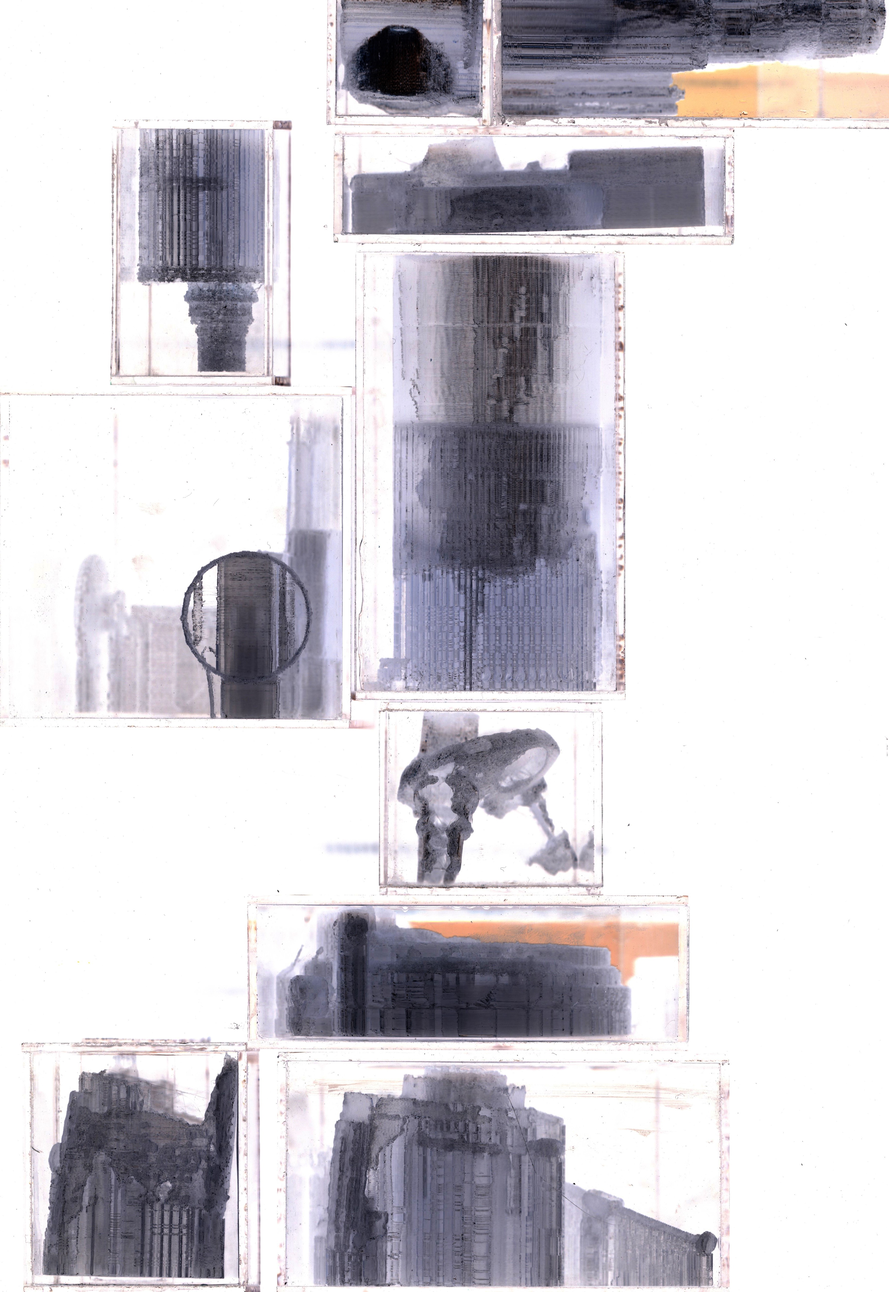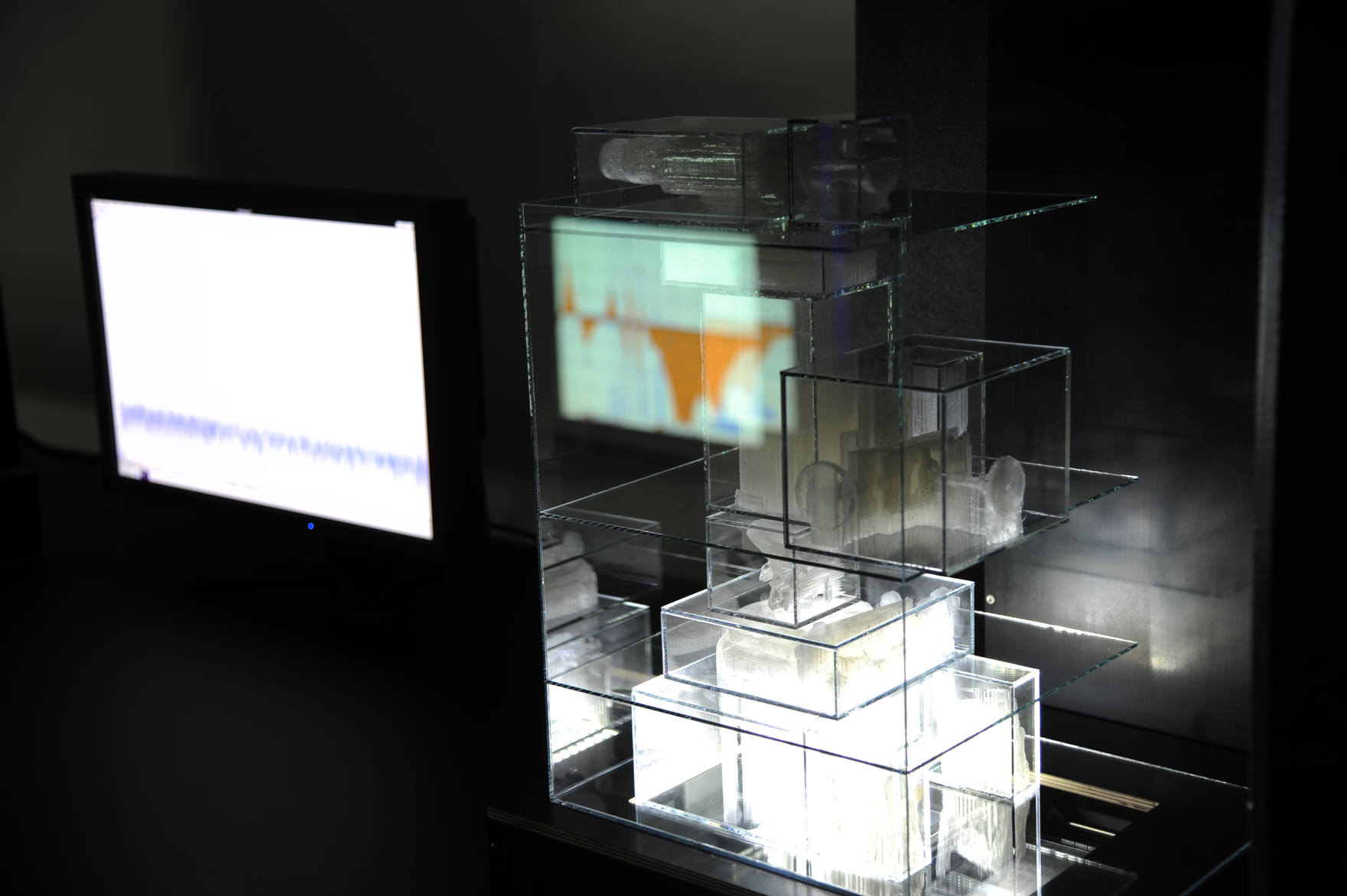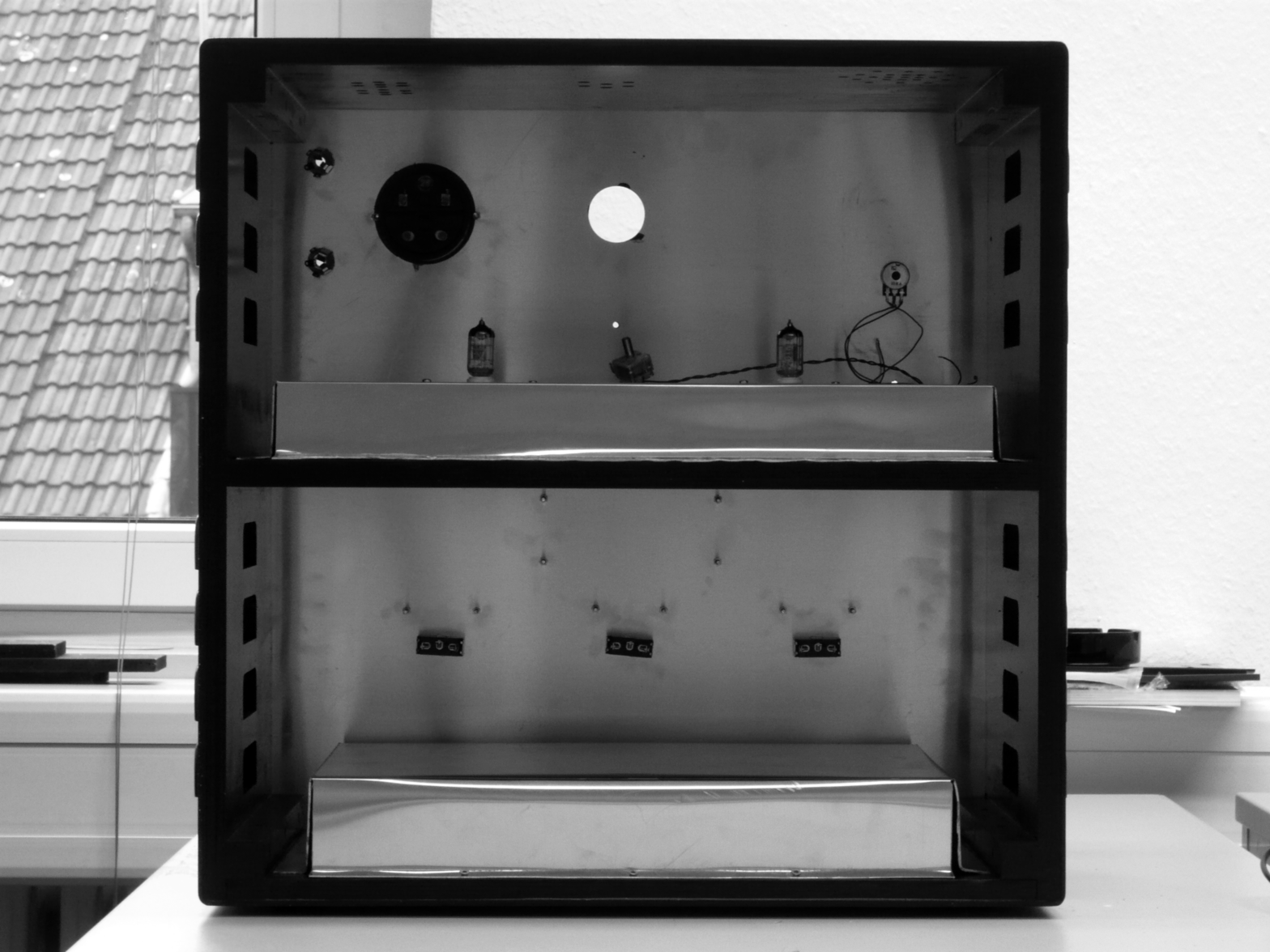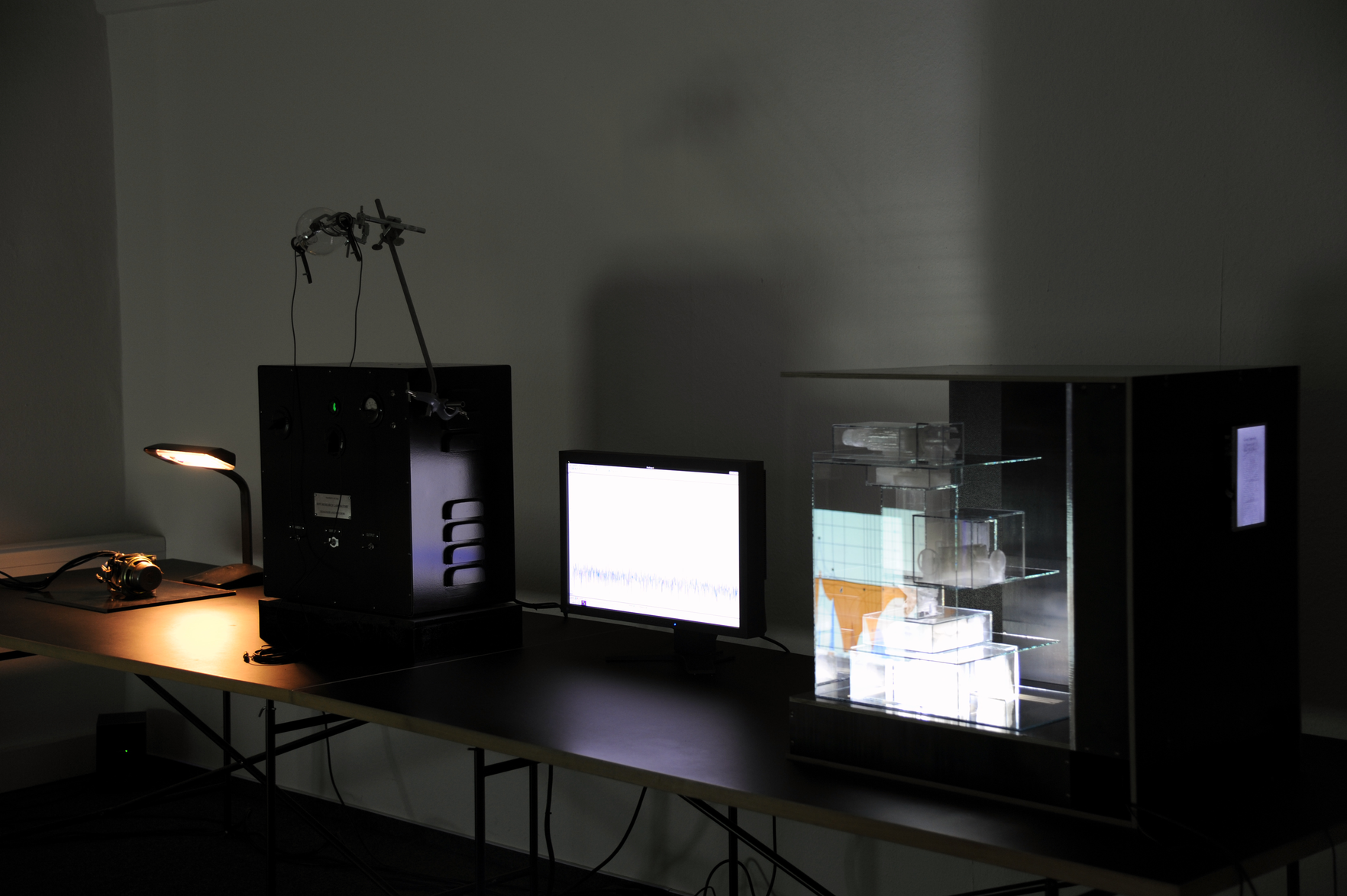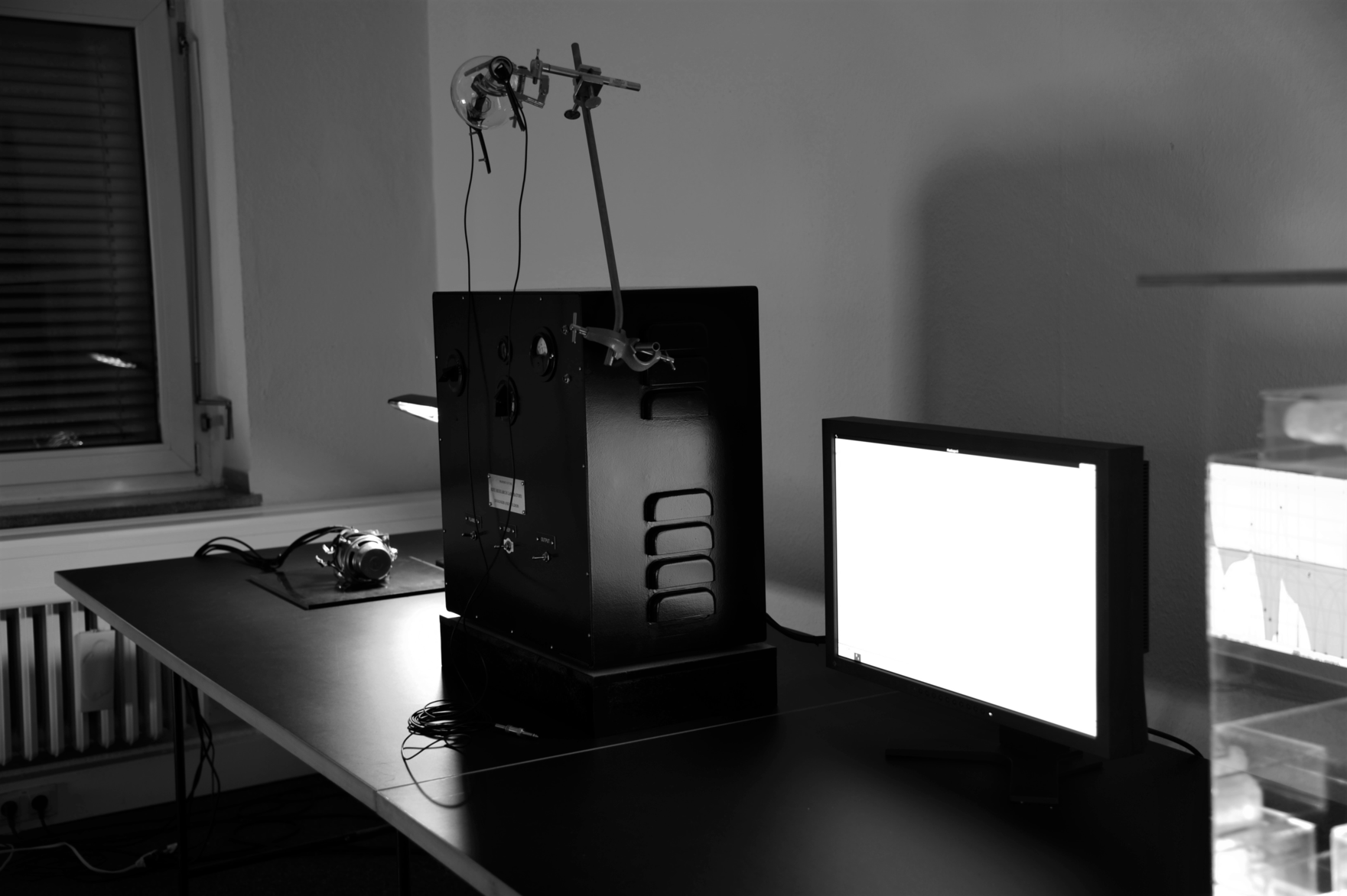The Last Prototype: The 5th Rife Microscope
The 5th Rife microscope was the last one of three prototypes created between 2011 and 2015. Microscope No. 5 was scanned with a 3D scanner in the Science Museum of London's storage site, in a scanning process carried out from December 3 to December 6, 2013, using a Next Engine laser scanner. Different reproductions were created from the scanned files, including 3D prints, cyanotypes, and 3D animations. In the 3D prints, the 3D printer's transparent polylactide (PLA) filament carries messages of errors brought to the surface of the object by the scanning process.
During the scanning process, the scanner generates layered surfaces from the scanned parts of the object. These layers are then converted into a final digital object file (.obj) or stereolithography file (.stl) for 3D printing. The gaps between these layers are often fragmented because the highly reflective surface of the microscope was sometimes unreadable by the laser scanner. The 3D printed parts of Rife’s microscope no. 5 look like fossils, fragmented imprints of artefacts. Their surface reflects the malfunctions of the scanning process and the layers of digital-to-real reproduction methods. They are the products of a direct analysis, where the object is present in its existing form and through the creation of a digital mould or cast.
Screenshot from Cinema4D digital rendering of the optical lenses in Royal Raymond Rife's Microscope No. 5. From the project, ∂ Topological Landscapes, 2012-2015. András Blazsek.
The Second Prototype: The Clinical Instrument
Rife’s Beam Ray Clinical Instrument is an obsolete device. Its reproduction, made for ∂ Topological Landscapes, was created in 2013 using archival photographs, written sources, as well as data and images from rife.org, the website run by Rife enthusiast Stanley Truman, Jr. This reproduction is closer to what one would expect a contemporary artist to produce, interested more in the object’s aesthetic qualities than a scientist interested in the object’s functionality. It plays the part of a three-dimensional reproduction of the object, like a later generation version of the photographs of artist Thomas Demand, in particular Control Room (2011), which shows a scene from a photograph taken at the Fukushima Power Plant after a reactor breakdown. Demand’s simulated spaces are like Rife’s similarly inaccessible instruments in history. The reproduction of certain objects can revaluate those objects, giving them a new value or importance.
Rife’s original Beam Ray Clinical Instrument was developed for healing purposes. It allegedly used specific frequencies to kill bacteria and viruses in the human body. The instrument was equipped with two different oscillators: a tube oscillator for the main or carrier frequency (3.8 MHz) and a variable oscillator designed to change the carrier frequency and convert the device into a variable frequency instrument (Graff 2010, 32). According to A History of Rife's Instruments and Frequencies (2010), a book available on the rife.org website, the cathode ray helium tube projected the end frequency and generated harmonics to activate the healing process (Graff 2010, 2).
Photo microgram from a file of documents with Royal Raymond Rife's Microscope No. 5 (ca. 1935; object no. 1990-668, Science Museum, London). Photograph by András Blazsek.
Screenshot from Cinema4D digital rendering made in 2013 of a knob on Royal Raymond Rife's Beam Ray Clinical Instrument. From the project, ∂ Topological Landscapes, 2012-2015. Courtesy of the artist, András Blazsek.
Screenshot from Makerbot software during preparation to print one part of a 3D scan of Royal Raymond Rife's Microscope No. 5 for The 5th Rife Microscope. From the project, ∂ Topological Landscapes, 2012-2015. András Blazsek.
There seemed to be nothing particularly remarkable about the instrument except that it has been constructed in such a way [as] to make the work of microscopy tedious and cumbersome, particularly in respect of focusing the instrument. Using all the original optics it was quite impossible to obtain an image, but using a light source, eye-piece and objective from a Reichert microscope, a very imperfect image of leukaemic blood cells was finally obtained. The image was about 30 percent larger than would have been expected with the use of a x6 eye piece and a x40 objective, and this was no doubt due to the prismatic arrangement in the barrel of the microscope. The resolution, however, was extremely poor.
After more than three hours work, we concluded that it would have been impossible to have produced the known photomicrographs with this instrument and it became clear to me that this explained the late Dr Gonin’s complaint that he could obtain no results ....
One of the original photographs which was labelled ‘virus of cancer’ was identified by Professor Welford as a well-known artefact of optical systems known as ‘coma’. It is merely a photographic rendering of an anomaly produced by defects in the optical system. (Bracegirdle 2003, 471)
Can you imagine a motion picture film whose hero is tiny enough to use the head of a pin for a ballroom floor and invite all his neighbours to come for a dance? Can you imagine the film showing that tiny hero being formed within the egg, breaking the shell to escape, living the normal span of life and dying at a ripe old age? (The San Diego Union 1929, 1)
Visualize a metal cabinet, somewhat larger than a radio, with a nickel-plated arm projecting from the top. At the end of the nickel arm is a very scientific-looking large glass bulb. When certain dials are turned a film of violet flame, or light, plays over the filament, after the manner of the gas in a neon tube. Hold your palm against the flow of light and you can feel a gentle tingling sensation.
This is the Rife Ray, developed in the laboratory of Dr. Royal Rife on Point Loma, after many years of patient scientific labor. The machine is intended to destroy a host of microbes and disease-producing organisms which have plagued mankind since the dawn of time.
The mechanism of the cabinet is sealed against inspection and few men besides Dr. Rife understand its principle. However, the general idea is that the ray produces vibrations of a frequency which instantly destroys many kinds of bacteria without affecting human tissue.
Will the Rife Ray do these things? ('Great Interest Is Shown', 1938).
Introduction: On media archaeology and the topology of boundaries
Media archaeology is a multidisciplinary field that brings together the disciplines of media theory, media art, film theory, and history. It incorporates film and cinema studies, the history and developments of optical apparatuses from the early modern era to the present, and looks at how technologies like the camera obscura, photography, and the moving image became part of everyday life to later be replaced by newer mediums like television, video, and 3D animation (Parikka 2012). The transmedia series ∂ Topological Landscapes (2015 – ongoing) presents a cross-section of media archaeology’s development from the early twentieth century. It investigates two obsolete instruments, one for magnification and one for frequency propagation, reframing them in the age of digital reproduction
The timeline of this research starts in 1930s America when controversial inventor Royal Raymond Rife (Nebraska, 1888 – California, 1971) started to develop his optical instruments. His early-twentieth-century studies in frequency theory and pleomorphism were applied to explorations of formal differentiation in viral cells. One of Rife’s aims was to develop methods and mechanisms that would allow him to use frequencies to kill viruses, and he claimed to have accomplished this through visual observation of living organisms.
Rife’s work was preserved and archived over the decades by enthusiasts. It is alleged to have started thanks to the young Rife’s employer, Henry Timken of the Timken Roller Bearing Axle Company in San Diego (Bracegirdle 2003, 459). Timken hired him as a chauffeur and, noticing his hobby interest in microscopy and optics, supposedly supported his training in Germany (Bracegirdle 2003, 459). Almost a century later, high magnification using compound microscopes has still not achieved the level of magnification that Rife claimed for the Universal Microscope, his most praised instrument. In its three component projects, ∂ Topological Landscapes works with different technologies of reproduction using 3D animation, 3D printing, sonification, and prototype-making to explore findings from attempts to replicate Rife’s instruments.
Archives and historical data are important for this research which, through media archaeology, investigates the question of how a specific type of neglected knowledge — a way of doing and looking at things that seems to be extinct in our present-day life — can find its way back, relevant not only as historical data in archives but, through artistic practice, as part of our material present and future (Parikka 2012). How can knowledge about Rife be reorganised by replicating the physical outcomes of his research: a 3D-printed sculpture of his compound microscope; a fabricated tube oscillator made from his beam ray clinical instrument; a sonic composition created for digital and analogue sound instruments based on Rife’s frequency studies. These hybrid objects inspired by Rife’s instruments act as conduits between past, present, and future.
∂ (curly d) is the symbol for ‘boundary’ in general topology, a field of study in mathematics. Topology (from the Greek topos meaning ‘place’, and logos meaning ‘that which is thought, considered, reckoned’) is the study of mathematical space, specifically the properties of an object under constant change. General topology is a branch of topology that studies its basic concepts, one of which, the boundary, is represented by ∂. In this research, ∂ is employed to focus attention on links between the study of shifting material surfaces and inquiry into the fluctuating borders between art and science. It posits that abandoned possibilities in scientific error and failed experiments may harbour other futures.
Beyond their materiality, these outcomes also create visual and sonic experiences in their environments. German media theorist Siegfried Zielinski’s research, published in Deep Time of the Media (2006), examines the sensual experience of media as they open into media archaeology to suggest that the timeline of media history ‘does not follow a divine plan’ from primitive media to more advanced (Zielinski 2006). The re-materialisation, visualisation, and sonification experiments in ∂ Topological Landscapes echo this assertion. The format of the present article and its use of reverse chronological order in the discussion of artworks also reflect this. A sound file is on auto-play to accompany reading. If no sound is heard, the reader should check their audio settings, scroll down to the bottom of the page and turn on the audio player.
Pasi Väliaho (2010, 9), who writes about the development of optical apparatuses, photography, and cinema, calls cinema ‘one of the predominant anthropological processes of modernity.’ This idea is in alignment with the observations of Hungarian-American constructivist artist László Moholy-Nagy, who saw the possibilities offered by the motion picture and placed cinema under a detailed analysis. Moholy-Nagy had significant experience in photography and photogram-making, which led him to film, but as a constructivist artist interested in the atomic structure of vision, his analysis on technologically aligned vision is most useful in this context. In A New Instrument of Vision, Moholy-Nagy (1936, 35) writes:
The First Prototype (Sound Transmitter) installed for live performance in 2012 at LACE, Los Angeles. From the project, ∂ Topological Landscapes, 2012-2015. András Blazsek. Photograph by Chris Wormald.
Perhaps this ‘transformation of our eyesight’ that Moholy-Nagy was observing trained and then fixed human perception, and it has subsequently failed to recognise the image of the ‘coma’ in Rife’s images as something worth exploring further, beyond just the image of a hoax. Was this just the manifestation of the failure of an optical instrument or also the symptom of transformed vision?
As 3D reproduction — including 3D animation, scanning, and printing — attracts increasing numbers of people and industries, can 3D reproduction offer the next step after cinema and microscopy to change our sensibility for objects? We have recently seen some of the traditional imaging methods like photography being adjusted to the new technology and creating images that, by showing the real world, seem to be closer to computer-generated images (CGI) than to traditional photographs. CGI is commonly associated with fantasy and science-fiction cinema, usually experienced as two-dimensional — existing only on screens — though they are created in a virtual 3D environment on the computer.
This realignment relates to the invention of new sensors in digital photography that have replaced the photographic chemicals of analogue photography. When these new sensors are used, the recorded images are transformed into digital data. Digital art is a mediation. As Christiane Paul (2015, 2) writes, ‘in digital art the visual results of the artwork … are derived from code and mathematical expression.’ The predictive vision tool provided by CGI technology — vision that provides something to be seen that previously could not be seen, i.e., a fantasy world — expresses itself not only through 3D animation and the use of software like Cinema4D or Blender, but also through digital images and digital photography. The digital transforms our sight to envision a new reality, fostering an anthropological transformation.
Digital photographs may show us images of reality. However, they also conceal their own process of production: ‘every act of digitization is a remediation, and any substantial repository exists in an infrastructure of metadata, information architecture, while every digital file has format specifications that are an abstraction from an analog artifact (or, are the features of a born digital one)’ (Drucker, personal communication with C. Bishop, 2017). With the recognition of the infrastructure behind all digital images, we can see something that is not really recognisable at first sight. These data-based images are images that have no physical presence; put simply, we rely on something we cannot see or have without the right mediator, the computer. As a result, these digital tools are the best techniques to use in exploring the ambiguity of Rife’s objects, themselves invented in the midst of what Moholy-Nagy (1936, 35) called a new ‘standard of visual perception’ taking shape. Rife’s microscopes were contributing to the development of this standard but failed to integrate themselves into it.
The seemingly unique and unknown method that Rife used to produce high magnification images with a compound microscope was defined by the degree of fear it inspired: ‘fear of the unknown is greater than fear of the unfamiliar,’ as Rife enthusiast and astrologist Barry Lynes (1987, 5) writes in his popular 1987 book about Rife. ‘Even scientists are not immune to this human instinct,’ Lynes insists in his crusade against historical neglect of Rife’s experiments (Lynes 1987, 5). The implication is that Rife’s experiments were neglected by the scientific community because of fear of his unknown method. The word ‘unknown’, compared with the word ‘unfamiliar’, provides no additional information; the pair seem to form a tautology. And yet, while the unknown is something that doesn’t exist within the range of our knowledge, the unfamiliar is something we have already framed a concept of but have had no chance to live with, to experience, or to become familiar with. This slight to no difference between the known and the familiar, the unknown and the unfamiliar, and the general lack of awareness of this gap is the same space occupied by the instrument-as-sculpture, by the tool-as-hoax that is evidence of an anthropological crisis of vision.
The First Prototype and Sound Reproduction
Sound reproduction targets the human perception of hearing and aims to capture a sound so that it can be heard again. Sonification takes numerical data or sound that is inaudible and renders it perceptible to our hearing. Therefore, it aims to translate the inaudible into the audible. The sound installation in ∂ Topological Landscapes uses sonification to create the sound of Rife’s frequencies.
Sonification, as the translation between sound and other senses, has a long history. Russian film director Dziga Vertov used the letters from the alphabet to express the soundscape of a wood factory at a time when no methods for sound reproduction were available (Smirnov 3013, 26). In the early years of the European and Russian avant-garde, there were many experiments in the area of synthetic sound reproduction and sound visualisation (Levin 2003, 50). Rudolf Pfenninger experimented with visualising sound, attempting to identify single sounds and assign a graphical value to each. He studied the shape of an audio signal on an oscilloscope until he could draw geometric forms that could then be captured by a camera and translated to an optical film soundtrack (Levin 2003, 53).
The sound installation of ∂ Topological Landscapes attempted to translate some of the recognisable healing frequencies from Rife’s research into audio frequencies to create a sound environment. The so-called ‘healing frequencies’ are much higher than audio frequencies, and are therefore inaudible. They are called healing frequencies because it is believed by some that they can heal organisms. The Mortal Oscillatory Rate (MOR) is a specific frequency band that, some purport, can kill a micro-organism (Graff 2010, 8). Rife proposed different frequencies for every disease. The list of the MOR frequencies is now available from various sources on the internet but these have been largely discredited by the medical establishment. The sound installation is based on the main principle informing Rife’s method. It looks for the right harmonics within the frequency spectrum where the harmonics unite with the major frequencies, giving an accord of consonance.
Sound composition generated by digital and analogue instruments in The First Prototype (Sound Transmitter). Waveform Audio File format (wav). From the project, ∂ Topological Landscapes, 2012-2015. András Blazsek.
Mapping Geographies and Other Endeavours
Since the four components of the three projects in ∂ Topological Landscapes were exhibited in 2015 as a multisensory environment in Cologne, Germany, at least three other artists have incorporated Rife’s research into their practice. Australian photographer Emmaline Zanelli’s RIFE MACHINE (2016–18), shown at ACE Open in Adelaide, featured images of figures in spaces tiled with printed photographs of the same images of figures in spaces. Because of the repetition of prints and images, Zanelli’s environments look like vibrating spaces that transport the audience ‘somewhere else’ (Zanelli, 2018). Zanelli uses the word ‘rife’ in two ways: first, she uses the adjective meaning ‘unchecked or widespread’ to refer to the proliferation of images that surround us; second, as a reference to a Rife machine she encountered in alternative treatment during a period of illness. Zanelli’s work is a metaphor for the proposition that the Rife machine can cure diseases by transmitting frequencies through the human body, as if we could use images to inoculate ourselves against images.
The music performance The Body Electric (2019), by Hong Kong-based sound artist Xper.Xr, used the idea of healing frequencies at Hong Kong’s Empty Gallery to present a healing session during the 2019–20 Hong Kong protests against the controversial Extradition Law Amendment Bill. Xper.Xr’s performance was realised using RifeTech instruments made by a Czech company. These instruments use a cathode ray tube and an oscillator device, components similar to those in Rife’s original Beam Ray Clinical Instrument. The performance was realised in the dark ambient space of the gallery in a former industrial building, where people gathered to heal and reflect. As the gallery stated in its press release, ‘it is with this perhaps naive wish to create a space for emotional and psychic healing that we asked Hong Kong artist and musician Xper.Xr. to organize The Body Electric’ (Empty Gallery, 2021). Xper.Xr accompanied his performance with a series of talks, one of which briefly discussed Rife’s instruments, but mostly using information readily available through platforms like Wikipedia. Unlike Zanelli, Xper.Xr seemed more interested in the power of the idea of pseudoscience than in metaphor.
Lastly, in her artist talk (2020) at the Graham Foundation in Chicago, American musician Whitney Johnson discussed her interest in the healing aspect of audio frequencies, presenting research on sounds and technologies that produce bodily responses (Graham Foundation, 2020). The description of Johnson’s talk mentions Rife’s name in the context of his claim that his Beam Ray Clinical Instruments could, as Johnson explains, ‘explode the ‘BX Virus Carcinoma’ and other pathogens by producing a resonant frequency at their ‘mortally oscillating rates’’ (Graham Foundation, 2020). Again, here the interest is in the broader notion of the human body’s reaction to frequencies, not specifically the case of Rife. Besides these instances of interest in Rife by artists from various geographies, there are several companies that sell devices like the RifeTech all around the world. All of these examples — artists and companies — show the post-internet condition of Rife’s research and the manner in which everyday mediatisation by the internet continues circulating Rife’s work, marking his instruments as a global phenomenon.
Research for ∂ Topological Landscapes on Rife’s instruments was conceived through fieldwork at the Scripps Institute of Oceanography in La Jolla, San Diego, and the Linda Vista Hospital in Los Angeles, as well as at the Science Museum in London. The 2012 performance at LACE responded to the context of Southern California, where the entertainment industry and interest in new religious movements meet science and technology. The invitation to perform at LACE started the three-year process of mapping Rife’s experiments. At this time in San Diego, it was already clear that the locations where Rife was working had almost no memory of the research that was supposedly developed at the Scripps cottages, now the location of the Scripps Institute of Oceanography. The surrounding area in La Jolla is one of the biggest biotechnology hubs of the United States, which hosts various start-ups and privately funded research backed by venture capitalists. The early articles on Rife from The San Diego Union and Evening Tribune indicate Rife’s research as pioneering in the beginnings of this neoliberal market around scientific exploration. However, without memory or archive, the evidence has moved from the local to the global electronic archive of the internet, where things have no physical forms, traces, and localities, but rather everything is caught in a changeable blur.
Conclusion: An art of refusal
Research on Rife’s instruments was an occasion to rethink the art-science binary from the perspective of an inventor whose ambiguous objects could find no place: neither science nor art. It aimed to make something visible, sonic, and touchable from this alienated position. The intense tracking and realignment process was only possible because the new standard of visual perception mediated through digital technologies permitted the modelling and fabrication of reproductions. The materialities and functions of these reproductions are a means to explore the hidden epistemologies of Rife’s instruments. ∂ Topological Landscapes orbits around aspects of Rife’s work that were never taken into consideration when the instruments were inspected as objects of scientific evidence. It instead lingers in neglected details, with an eye noting the fraudulent use and pseudo-scientific aspects inherent to Rife’s research, yet still seeing it as something beyond a hoax.
For this reason, the use of correct historical details is important. The analysis of these details required understanding the history of technical instruments from the field of natural sciences and involved the media archaeology of photography, cinema, and instruments of sound reproduction. However, media archaeology is not only about looking at the historical timeline of media instruments. Rather, its methodology insists that we ‘do not seek the old in the new, but find something new in the old.’ (Zielinski 2006, 3).
When the research was exhibited, visitors showed serious interest in the healing aspect of the radio frequencies, although the intention of the research was never to suggest that the art itself aimed to heal the audience with the use of audio frequencies. The possibility that art can be a kind of healing method is accepted in certain circumstances, but why does art seem to gain a special status in this regard? Anything can be therapeutic; the idea that only art is capable of such is a mystification of the concept. It is more interesting to think that Rife’s ambiguous instruments can have a second life in art, continuing to exist outside of the scientific world. In this way, one can, perhaps, think that these instruments have a special property to heal themselves in a world of fixed binaries (i.e., art and science) that they refuse.
Bibliography:
‘1939 Royal Rife Laboratory Film’ <https://www.rifevideos.com/Video/mp4/Dr._Rife_1939_Lab_Film.mp4> [accessed March 3, 2021]
Bracegirdle, Brian, ‘Rife and his microscopes,’ Quekett Journal of Microscopy, no. 39 (2003): 459–473.
‘Dread Disease Germs Killed By Radio Waves, S.D. Claim Specific Destroyer of all Deadly Microbes, Hope, Cancer Organism Isolated,’ The San Diego Union, (reported from Newell Jones, Evening Tribune), May 7, 1938, p. 2.
Drucker, Johanna and Claire Bishop, ‘A Conversation on Digital Art History,’ (June 23, 2017, and July 12, 2017) <https://dhdebates.gc.cuny.edu/read/untitled-f2acf72c-a469-49d8-be35-67f9ac1e3a60/section/3aedfd2c-280f-4029-b3f1-3e9a11794c01> [accessed May 4, 2021]
Graff, J. A., A History of Rife's Instruments and Frequencies (self-published PDF, 2003 and 2010) <http://www.rife.org> [accessed May 4, 2021]
‘Great Interest Is Shown in Rew Rife Ray,’ No Publication Title Listed. Lemon Grove, California, Friday, Sept. 23, 1938 <http://rife.org/newspaper/Interest.jpg> [accessed August 13, 2020].
Handel, Stephan, Listening: An introduction to the perception of auditory events (Cambridge: MIT Press, 1989).
Kendall, A I, and R. R. Rife. ‘Observations on Bacillus Typhosus in its Filterable State: A preliminary communication,’ California and Western Medicine, 35, no. 6 (1931): 409–411.
Lem, Stanislaw, Eden, trans. by Marc E. Heine (San Diego: Harcourt Brace Jovanovich, 1989).
Levin, Thomas Y. ‘”Tones from out of Nowhere”: Rudolf Pfenninger and the Archaeology of Synthetic Sound,’ Grey Room, 12 (2003): 32–79.
‘Local Man Bares Wonders of Germ Life New Apparatuses Unveil Hidden Microbe Universe To Human Eye,’ The San Diego Union, November 3, 1929, p. 1.
Lynes, Barry, The Cancer Cure That Worked: 50 Years of Suppression (Compcare Pubns, 1987).
Moholy-Nagy, László, ‘A New Instrument of Vision,’ Telehor: The International Review New Vision, ed. by František Kalivoda (Brno: František Kalivoda, 1936), pp. 34–36.
Parikka, Jussi, What Is Media Archaeology? (Oxford: Polity Press, 2012).
Paul, Christiane, ‘From Immateriality to Neomateriality: Art and the conditions of digital materiality,’ paper presented at the in proceedings of the 21st International Symposium on Electronic Art (ISEA), Vancouver, 2015.
Seidel, R.E. and Winter, M. Elizabeth, ‘The New Microscopes,’ Journal of the Franklin Institute, 237:2 (1944): 104–130.
Smirnov, Andrey, SOUND in Z: Experiments in Sound and Electronic Music in Early 20th Century Russia (Köln, Deutschland: Buchhandlung Walther Konig GmbH & Co. KG. Abt. Verlag, 2017).
‘The Body Electric,’ Empty Gallery <https://emptygallery.com/events/20191130-the-body-electric/> [accessed March 4, 2021]
‘Whitney Johnson Artist Talk,’ Graham Foundation <http://www.grahamfoundation.org/public_events/6063-whitney-johnson>[accessed March 4, 2021]
Zanelli, Emmaline, ‘RIFE MACHINE,’ <https://emmalinezanelli.com/RIFE-MACHINE>[accessed March 4, 2021]
Zielinski, Siegfried, Deep Time of the Media: Toward an Archaeology of Hearing and Seeing by Technical Means (Cambridge: MIT Press, 2006).
Optical parts of Royal Raymond Rife's Microscope No.5 (ca. 1935; object no. 1990-668, Science Museum, London) photographed in 2013 during 3D scanning for the project, ∂ Topological Landscapes, 2012-2015. Photograph by András Blazsek.
Royal Raymond Rife's Microscope No.5 (ca. 1935; object no. 1990-668, Science Museum, London) photographed in 2013 during 3D scanning for the project, ∂ Topological Landscapes, 2012-2015. Photograph by András Blazsek.
Digital image generated by a document scanner from segments of The 5th Rife Microscope. From the project, ∂ Topological Landscapes, 2012-2015. András Blazsek.
In his exploration of the relationship of media archaeology to the senses, new media theorist Jussi Parikka (2012, 21) quotes late-nineteenth-century physicist Robert Koch’s article ‘Zur Untersuchung von pathogenen Organismen’ (On the Investigation of Pathogenic Organisms) stating, ‘the photographic picture of a microscopic object can under certain circumstances be more important than [the object] itself.’ This was indeed the case to some extent in the instance of Rife’s microscope. Microscope No. 5 and the archival materials from the Science Museum seem to offer striking evidence that the instrument failed to be the scientific achievement that would help humanity fight cancer. There is the sense that without the appearance of the image of the ‘coma’ in the archive — an image which, in the eye of a scientist, is a suspicious mistake — the instrument could have become part of everyday medicine. But the ‘coma’ is also an important artefact of the moment when humanity started to look at the world through new apparatuses and see things differently. For example, in 1929, a short article in The San Diego Union (1929, 1) about Rife’s microscope exclaimed ‘Local Man Bares Wonders of Germ Life. New Apparatuses Unveil Hidden Microbe Universe to Human Eye’ and asked:
The Environment of ∂ Topological Landscapes
In the work titled ∂ Topological Landscapes, different media — 3D printed sculpture, 3D animation, video, and digital sound — contribute to the creation of an environment that is both hermetic and hermeneutic. It is hermetic in the sense that it involves enigmatic objects connected to Rife’s controversial research; it is hermeneutic in the sense that it offers those who visit it the opportunity to experience versions of these objects in encounters that allow them and their uses to be interpreted. Without any interpretation that puts these objects into specific contexts, they would be impenetrable. The inspiration for the project was to find a way to help these imperceptible objects become discernible.
Most of the objects situated inside the environment for ∂ Topological Landscapes are end products of a contemporary consumer-grade reproduction system involving 3D scanning and 3D printing as rapid prototyping and CGI animation, available on the technology market. All apparatuses that came out of the Rife Laboratory in San Diego raised doubts about their functionality and advanced operation. Their malfunctions have created a fiction around them and left people experiencing cancer with both doubt and hope. It is, in fact, exactly this condition of these instruments as prototypes that is of particular interest.
Prototypes propose a possible functioning object while also reflecting the errors the inventor made in the course of an object’s development. A prototype can go into production only after having been properly tested and verified for functionality. Prototypes are to be fine-tuned to meet the required standards. The objects 5th Rife Microscope, the Clinical Instrument, and the Transistor from the series ∂ Topological Landscapes are all manipulated: they are all essentially prototypes. These prototypes also show something about the process by which they were replicated, with errors reflected in their surfaces. Incorporated into their materials, they ‘reveal their own coded materiality as part of their form, thereby becoming themselves a residue of digital processes’ (Paul 2015, 2). Moreover, they are broken in their functionality as an instrument. As they may never actually become fully functional, they are all somehow dead.
The connection between error, or malfunction in the absence of maintenance, and the state of being dead, can be introduced through a novel by the well-known Polish science-fiction writer Stanislaw Lem. Objects produced through aggregated reproduction processes are described as ‘dead’ in Lem’s novel Eden (1958). On the fictional planet Eden, the first sign of civilisation that astronauts have contact with is an abandoned factory producing undefinable products. First, they are amazed by the appearance of the objects, having never seen such objects before. Only later, as they are trying to recover the functionality of the objects, do they realise that the circuit connections inside the objects make no sense. When they start following the steps of production, they notice that the end product returns to the beginning of the assembly line and that the parts are used again in a new production cycle. The errors in the production process accumulate and the result is a purely nonsensical product, which is, however, visually attractive. Through the complexity of the original object and the errors inherent to the 3D scanning and printing processes, the replicated and 3D printed microscope occupies the same uncanny state of being ‘dead’.
About Royal Raymond Rife: Beyond the binary of functional tool and fraudulent hoax
Royal Raymond Rife was the inventor of a cancer treatment that used high-frequency radio waves to kill viruses and bacteria in the human body (Bracegirdle 2003, 460). During the development of the treatment, conducted in San Diego between 1929 and 1938, Rife designed compound microscopes with remarkably high magnification to observe live bacteria (Kendall & Rife 1931, 409). His research into light microscopy and radio frequencies was questioned by the American Medical Association, and thus never had the opportunity to be properly explored for potential use in healing practices (Bracegirdle 2003, 460). His obscure practice is, therefore, often referred to as ‘pseudoscience’; outside of the United States, however, questions about the success of his methodology have generated alternative cancer treatments, for example, in Northern Mexico, where he lived for a while (Bracegirdle 2003, 460).
According to archival materials from the Science Museum in London, Rife somehow managed to combine his studies of light refraction and specimen staining with the discovery of pleomorphism to observe viruses in living form under very high magnification (Seidel and Winter 1944, 117–120). This allowed him to record the reactions of different viruses to projected radio frequencies. The determination of frequencies to which the viruses vibrate led Rife to create large oscillator devices that, he proposed, could project recorded frequencies onto the human body (Bracegirdle 2003, 460). Effectively, Rife was using phase cancellation to kill viruses.
Phase cancellation is a phenomenon in physics in which two identical but shifted frequencies combine. Two identical and superimposed sine waves — one of which is set 180 degrees out of phase of a cycle — create zero intensity in the sum of the amplitude of the two signals. To put this technical description more simply, the shifted amplitudes of the two signals cancel each other out (Handel 1989, 14). Rife recorded observations from living cancer cells with a compound microscope that he built and, with the help of electrical engineer Philip Hoyland, built several oscillator devices referred to as ‘frequency devices’ (The San Diego Union, 7 May 1938, 2) for use in clinical trials at the Linda Vista Hospital in Los Angeles. In 1938, a court case between Hoyland and the Beam Ray Company began (Rife, personal communication with B.W. Gonin, 14 May 1938). This event seems to be one of the main forces that helped dismantle Rife’s scientific laboratory work in San Diego. An unidentified newspaper clipping ('Great Interest is Shown', 1938) from early 1938, posted on the website of a Rife researcher and enthusiast, urges readers to imagine an instrument that can accomplish all kinds of feats:
During the last century, Rife’s instruments became obsolete objects that could only survive through the work of enthusiasts who replicated them, giving them new shapes or reproducing them with updated technology. The author of the article preserved in the online clipping concludes with the question of whether this instrument, also called the Rife Ray, can really accomplish all that is proposed. The different replicas of Rife’s apparatuses — not only the works in ∂ Topological Landscapes, but many others — are an occasion to reflect on how thinking about these instruments might move beyond the dichotomy of functional tool and fraudulent hoax to engage with the ambiguous space in-between.
The Ambiguity of Rife’s instruments
Archival research for ∂ Topological Landscapes included the examination and 3D scanning of an object coded 1990-667, held at Blythe House, the storage facility of the Science Museum in London. 1990-668 is Rife’s prismatic compound microscope (no. 5), one of the few remaining Rife microscopes. The long investigation of this object and its archival documents raised further questions about the reliability of Rife’s discoveries. One of these documents was an article written by Brian Bracegirdle (2003), a staff member at the museum who wrote extensively on microscopy. In his 2003 essay, ‘Rife and his Microscopes’, published in the Quekett Journal of Microscopy, Bracegirdle analyses different examination results of the microscope and concludes, ‘I can say with certainty that no one could use this instrument to make a series of high power observations.’ (Bracegirdle 2003, 470).
Besides this source, there are only two other documents archived at the museum that discuss the works of Rife: ‘Observations on Bacillus Typhosus in its Filterable State’ (Kendall & Rife 1931) published by California and Western Medicine (the Western Journal of Medicine until 2002) and the other, a piece titled ‘The New Microscopes’ (Seidel and Winter 1944), published by the Journal of the Franklin Institute, one of the longest-running scientific journals in the US. All the remaining documents are articles from San Diego newspapers, specifically The San Diego Union and The Evening Tribune.
The essay by Bracegirdle (2003, 471) also included a report by a man referred to as Dr. Duggan, who is said to have taken microscope no. 5 to the Department of Physics at Imperial College to examine it in detail with another professor named Walter Welford.
Installation view of The First Prototype (Sound Transmitter), The Clinical Instrument and The 5th Rife Microscope exhibited at the Academy of Media Arts, Cologne, 2015. From the project, ∂ Topological Landscapes, 2012-2015. Photograph by András Blazsek.
Installation view of The 5th Rife Microscope exhibited at the OFF-Biennale Budapest, 2015. From the project, ∂ Topological Landscapes, 2012-2015. Courtesy of the artist, András Blazsek. Photograph by Ádám Tábori.
Installation view of The 5th Rife Microscope exhibited at the OFF-Biennale Budapest, 2015. From the project, ∂ Topological Landscapes, 2012-2015. András Blazsek. Photograph by The Orbital Strangers Project/OFF-Biennale Budapest Archive
‘Local Man Bares Wonders Of Germ Life. New Apparatuses Unveil Hidden Microbe Universe To Human Eye.’ The San Diego Union, November 3, 1929.
Digital image generated by a document scanner from segments of The 5th Rife Microscope (3D print in transparent PLA and glass containers). From the project, ∂ Topological Landscapes, 2012-2015. András Blazsek.
[I]t is, for instance, an immense extension of the optical possibilities of reproduction that we are able to register precise fixations of objects, even in the most difficult circumstances, in a hundredth or thousandth of a second. Indeed, this advance in technique almost amounts to a psychological transformation of our eyesight, since the sharpness of the lens and the unerring accuracy of its delineation have now trained our powers of observation up to a standard of visual perception which embraces ultra-rapid snapshots and the millionfold magnification of dimensions employed in microscopic photography. (Moholy-Nagy 1936, 35)
In 2012, a performance at LACE (Los Angeles Contemporary Exhibitions) presented the first version of the sound installation as a live performance. Through a Digital Audio Workstation (DAW) with digital oscillators and audio filters, transmitter devices opened basic sine wave audio frequencies to a richer spectrum. Audio filters controlled the harmonics of the soundscape. The transmitter is a self-made instrument that transmits a sine wave — a wave produced by a digital oscillator — to a 16-channel filtering system in a computer, where all the modulated sine waves and the full spectrum of harmonics can be controlled. The composition creates a sound environment whose final characteristics are defined by a set of constraints: the base frequency, the environment, the feedback, and the 16 harmonics.
The transmitter is the core of the system and was built from two consumer-grade loudspeakers. One speaker projects sound, the other receives it. Sine waves transmitted through this instrument can be described as expanded waves. When a sine wave enters into a physical environment, it starts to interact with it and adds additional tones to the original sine wave; it utilises harmonics through reverberations in the environment. The transmitter was the first manifestation of the Rife research and was used as a base to create a later sound installation.
A key part of the sound installation is its contact with its surrounding reality. Such was also the case for Rife’s Beam Ray Clinical Instrument, in which harmonics were added through the transmission of cathode ray tubes (Graff 2010, 43). Although the instrument was only generating the MOR frequencies identified by Rife, its internal tubes were made of glass, and the resonance of the material expanded the harmonic spectrum.
Screenshot from Raven Lite software showing the spectrogram of sound composition generated by digital and analogue instruments associate with The First Prototype (Sound Transmitter). From the project, ∂ Topological Landscapes, 2012-2015. András Blazsek.
The First Prototype (Sound Transmitter) exhibited at the Academy of Media Arts, Cologne, 2015. From the project, ∂ Topological Landscapes, 2012-2015. Photograph by András Blazsek.
The 5th Rife Microscope (3D print in transparent PLA and glass containers). From the project, ∂ Topological Landscapes, 2012-2015. Photograph by András Blazsek.
The Clinical Instrument (casing and tube oscillators, 2013) exhibited at the Academy of Media Arts, Cologne, 2015. Reproduction of Royal Raymond Rife's Beam Ray Clinical Instrument made from photographs of the original. From the project, ∂ Topological Landscapes, 2012-2015. Photograph by András Blazsek.
The functioning part of the reproduction was made after investigating the 2010 publication. The resulting Clinical Instrument has a 3.8 MHz oscillator and a lower frequency oscillator designed to change the frequency harmonics, but it does not allow cathode rays to be emitted. To conduct a real experiment, this functionality would need to be enabled. Thus, the last thing that would make the device fully functional is actually missing. In operation, therefore, the object is dead, a fossil of sorts; the visitor receives visual feedback about the frequencies used through a built-in oscilloscope (a PicoScope), but this only generates further ambiguity about the real content of the work.
Screenshot from Picoscope software showing tube oscillators in The Clinical Instrument set on 3.8 MHz and 139.000 Hz frequencies. From the project, ∂ Topological Landscapes, 2012-2015. András Blazsek.
Schematic drawing of the path that light takes traveling through the optical lenses of Royal Raymond Rife's Microscope No. 5. From the project, ∂ Topological Landscapes, 2012-2015. Courtesy of the artist, András Blazsek.
Optical parts of Royal Raymond Rife's Microscope No.5 (Object no. 1990-668, Science Museum, London) photographed in 2013 during 3D scanning for the project, ∂ Topological Landscapes, 2012-2015. Photograph by András Blazsek.
Photocopy of an unattributed schematic drawing from a file of documents with Royal Raymond Rife's Microscope No. 5 (ca. 1935; object no. 1990-668, Science Museum, London). Photograph by András Blazsek.
The First Prototype (Sound Transmitter) installed for live performance at LACE, Los Angeles, 2012. From the project, ∂ Topological Landscapes, 2012-2015. Courtesy of the artist, András Blazsek. Photograph by Chris Wormald.
Detail of The 5th Rife Microscope exhibited at the Academy of Media Arts, Cologne, 2015. From the project, ∂ Topological Landscapes, 2012-2015. Photograph by András Blazsek.
Insideout, video, 2015. 3D animation from the project, ∂ Topological Landscapes, 2012-2015. András Blazsek.
On Light and Sight, video, 2014. 3D animation from the project, ∂ Topological Landscapes, 2012-2015. András Blazsek.
The 3D Animation
In the animation, a slow camera movement shows fragments of a geometrical structure — the optical lenses of microscope No. 5 reconstructed in Cinema4D — through a clear black 3D rendered environment. As it moves, the camera follows a path based on two drawings of the way light refracts through the microscope’s lenses. The camera focuses on a hypothetical non-existent object that moves along the same path through the system of lenses. In the animation, viewers feel as though they are moving through the lenses, so they cannot see the lenses in themselves or as a whole and cannot perceive the structure that they are a part of. However, the animation is a theatrical experience of sorts that gives the affective experience of the light itself as it moves through the lenses, allowing the viewer to see the movement of light that would produce microscopic vision. In a parallel image inside the same video frame, blurry video images taken through the microscope’s lenses show an architectural environment. Parallel to the ‘imagined’ interior of microscope No. 5, the viewer can experience the building where the object is conserved through the optical lenses of the microscope itself.
Projection of the digital instrument from The First Prototype (Sound Transmitter) exhibited at the Academy of Media Arts, Cologne, 2015. From the project, ∂ Topological Landscapes, 2012-2015. Photograph by András Blazsek.
The Clinical Instrument (2013) exhibited at the Academy of Media Arts, Cologne, 2015. From the project, ∂ Topological Landscapes, 2012-2015. Photograph by András Blazsek.
